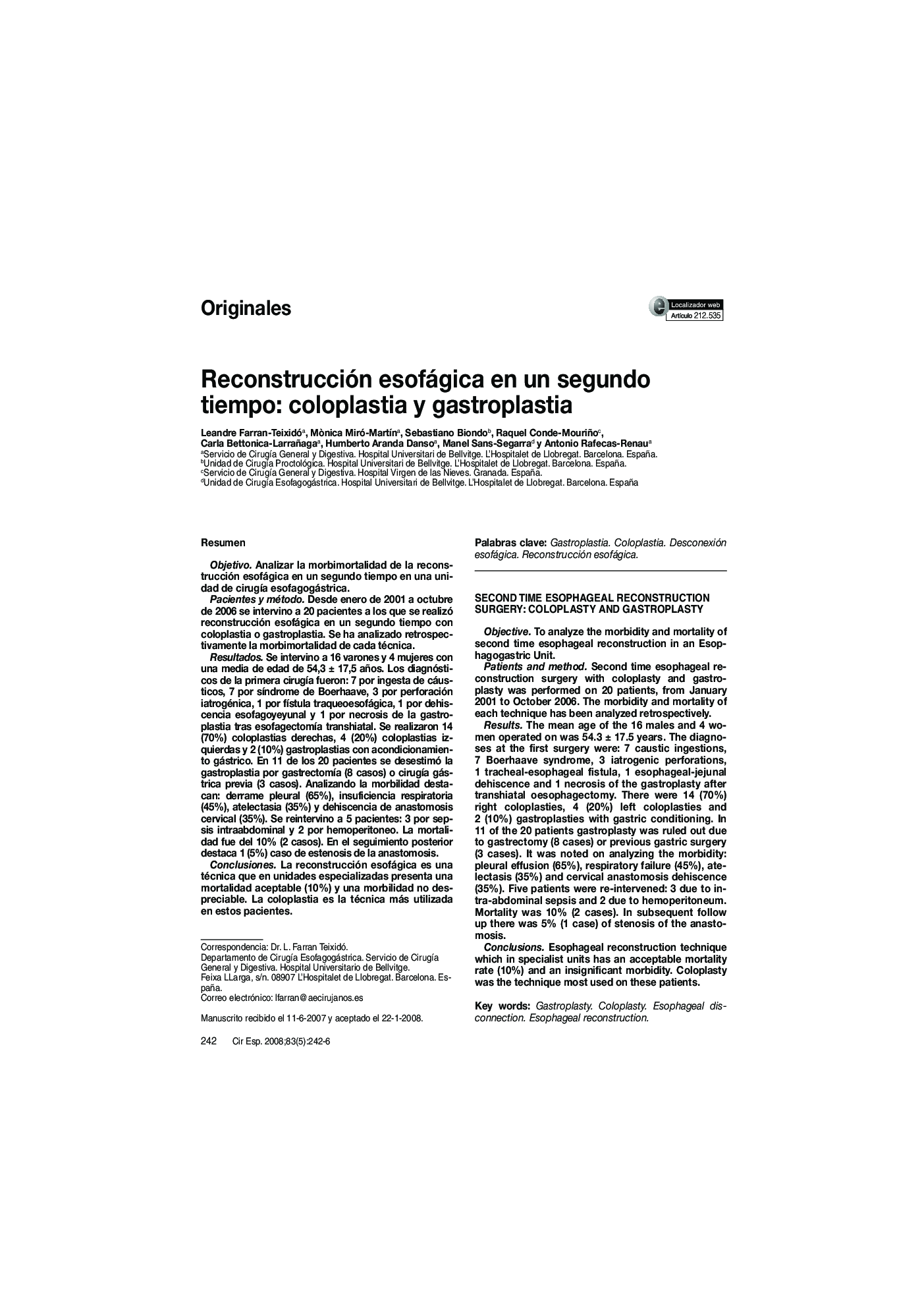| Article ID | Journal | Published Year | Pages | File Type |
|---|---|---|---|---|
| 4253552 | Cirugía Española | 2008 | 5 Pages |
ResumenObjetivoAnalizar la morbimortalidad de la reconstrucción esofágica en un segundo tiempo en una unidad de cirugía esofagogástrica.Pacientes y métodoDesde enero de 2001 a octubre de 2006 se intervino a 20 pacientes a los que se realizó reconstrucción esofágica en un segundo tiempo con coloplastia o gastroplastia. Se ha analizado retrospectivamente la morbimortalidad de cada técnica.ResultadosSe intervino a 16 varones y 4 mujeres con una media de edad de 54,3 ± 17,5 años. Los diagnósticos de la primera cirugía fueron: 7 por ingesta de cáusticos, 7 por síndrome de Boerhaave, 3 por perforación iatrogénica, 1 por fístula traqueoesofágica, 1 por dehiscencia esofagoyeyunal y 1 por necrosis de la gastroplastia tras esofagectomía transhiatal. Se realizaron 14 (70%) coloplastias derechas, 4 (20%) coloplastias izquierdas y 2 (10%) gastroplastias con acondicionamiento gástrico. En 11 de los 20 pacientes se desestimó la gastroplastia por gastrectomía (8 casos) o cirugía gástrica previa (3 casos). Analizando la morbilidad destacan: derrame pleural (65%), insuficiencia respiratoria (45%), atelectasia (35%) y dehiscencia de anastomosis cervical (35%). Se reintervino a 5 pacientes: 3 por sepsis intraabdominal y 2 por hemoperitoneo. La mortalidad fue del 10% (2 casos). En el seguimiento posterior destaca 1 (5%) caso de estenosis de la anastomosis.ConclusionesLa reconstrucción esofágica es una técnica que en unidades especializadas presenta una mortalidad aceptable (10%) y una morbilidad no despreciable. La coloplastia es la técnica más utilizada en estos pacientes.
ObjectiveTo analyze the morbidity and mortality of second time esophageal reconstruction in an Esophagogastric Unit.Patients and methodSecond time esophageal reconstruction surgery with coloplasty and gastroplasty was performed on 20 patients, from January 2001 to October 2006. The morbidity and mortality of each technique has been analyzed retrospectively.ResultsThe mean age of the 16 males and 4 women operated on was 54.3 ± 17.5 years. The diagnoses at the first surgery were: 7 caustic ingestions, 7 Boerhaave syndrome, 3 iatrogenic perforations, 1 tracheal-esophageal fistula, 1 esophageal-jejunal dehiscence and 1 necrosis of the gastroplasty after transhiatal oesophagectomy. There were 14 (70%) right coloplasties, 4 (20%) left coloplasties and 2 (10%) gastroplasties with gastric conditioning. In 11 of the 20 patients gastroplasty was ruled out due to gastrectomy (8 cases) or previous gastric surgery (3 cases). It was noted on analyzing the morbidity: pleural effusion (65%), respiratory failure (45%), atelectasis (35%) and cervical anastomosis dehiscence (35%). Five patients were re-intervened: 3 due to intra-abdominal sepsis and 2 due to hemoperitoneum. Mortality was 10% (2 cases). In subsequent follow up there was 5% (1 case) of stenosis of the anastomosis.ConclusionsEsophageal reconstruction technique which in specialist units has an acceptable mortality rate (10%) and an insignificant morbidity. Coloplasty was the technique most used on these patients.
